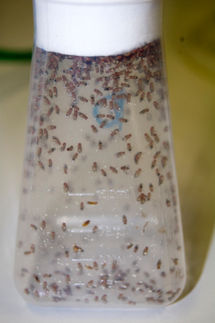Using yeast to identify cancer genes
Researchers use yeast to identify cancer-causing genes that may also occur in humans
Advertisement
Identifying cancer-causing genes is a major challenge, but now Cornell scientists have devised a technique using yeast cells to identify new cancer genes that may also be found in humans. The study, published in Public Library of Science biology, is the first to report on mutations in yeast that lead to accelerated cell growth, similar to cancerous tumors. The findings also have implications for better understanding cellular metabolism, surveillance systems and growth maintenance.
Biological pathways and genes that regulate cell proliferation rates are likely conserved from yeast to such complex organisms as animals, plants and fungi - which means that these genes are fundamental to life and have stayed the same, or nearly so, over millions of years of evolution. Locating cancer-causing genes known as oncogenes in yeast gives researchers major clues about where to find them in humans.
"This paper provides a model to identify and map oncogenes," said Xin Li, the paper's lead author. Li is a postdoctoral researcher in the lab of Bik Tye, professor of molecular biology and genetics and the paper's senior author. "Assuming that a lot of pathways are conserved, the yeast model provides a scheme to identify those genes," Li added.
The study also argues against an assumption that abnormalities in chromosome number and structure -- called aneuploidy - are a major cause in cancer. When aneuploidy occurs, a cell may have more or fewer chromosomes than normal. Aneuploidy is a consistent hallmark of cancer, and researchers have speculated that these chromosomal abnormalities may increase the numbers and expression of cancer-causing genes, leading to more disease.
While researchers have not been able to remove aneuploidy from mammalian cancer cells to study the effects of oncogenes by themselves, this study describes a new method to reconstruct yeast without aneuploidy but with genetic mutations that cause cells to quickly proliferate.
"We used yeast genetic tools to remove aneuploidy, something we cannot do in a mammalian cell but we can do in yeast," Li said.
Yeast cells normally carry two sets of matching chromosomes, but they can survive with only a single set - known as a haploid state - which occurs when cells divide during meiosis. Some of these haploid cells lose their aneuploidy. The researchers crossed the aneuploidy-free, genetically mutated haploid cells to produce new yeast cells that still carry the mutations. These cells quickly proliferated, indicating that genetic mutations alone caused the rapid cell growth related to cancer.
"We are disproving that aneuploidy is involved in maintaining accelerated proliferation in our yeast cancer model," said Li. "We can now map those mutations that cause accelerated proliferation."



















































